A First-Timer's Guide to Camping in the Finger Lakes
The Finger Lakes region in New York is a beautiful place for outdoor fun. It has deep lakes, big waterfalls, and rolling hills. For a first time camper, it’s a great place to connect with nature.

But your first camping trip can feel like a lot to handle. You might wonder what to pack or where to go. This guide will help answer those questions and make you feel more prepared.
Planning Your First Camping Trip
When to Go Camping
The best time to camp in the Finger Lakes depends on what you want. You have to choose between good weather and fewer crowds. Each season offers a different kind of trip.
A Look at the Seasons
- Spring (April – Mid-May): The weather is mild, but it can change quickly. You’ll see fewer people, and the waterfalls are at their biggest. The main problems are chilly nights and muddy trails.
- Late Spring / Early Summer (Mid-May – Early July): We don't recommend this time for a first trip. The weather gets nicer, but this is peak season for black flies and ticks. The bugs can be very unpleasant and might ruin your trip.
- Summer (July – August): This is the most popular time to visit. The weather is warm, which is great for swimming and boating. The nights are comfortable for sleeping in a tent. The biggest challenge is that it's very crowded, and you have to book campsites many months ahead of time.
- Fall (September – October): Many people think fall is the best season here. You get to see amazing autumn colors with nice, cool weather. There are also fewer people and no bugs. The main thing to plan for is the cold, as nights can get chilly .
Summer offers the easiest weather but requires the most planning. Fall gives you a great experience but you'll need better gear to stay warm at night.
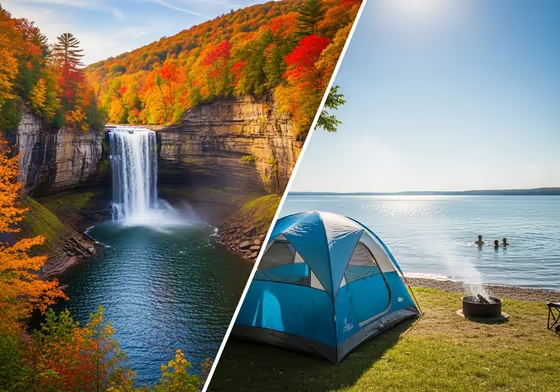
What to Wear in Summer vs. Fall
Your packing list will change a lot depending on the season.
-
What to Wear in July:
For July, you should pack for warm days and maybe some cool evenings.
- Day: Shorts, t-shirts, and sandals are perfect. A sun hat and sunglasses are a must.
- Activity: Bring swimsuits and towels for the lake.
- Night: Always pack a light sweater and a rain jacket. Evenings can get cool, and you might see a shower.
-
What to Wear in October:
Packing for October means you need to be ready for the cold.
- Day: Dressing in layers is the best way to stay comfortable. You'll want a base layer that wicks sweat, a warm fleece for the middle, and a waterproof jacket on the outside.
- Night & Sleep: This is very important for a good fall trip. Bring a warm hat, gloves, and wool socks. You should also have a special set of thermal pajamas just for sleeping. Avoid wearing cotton as your first layer because it holds moisture and can make you very cold.
Table 1: Finger Lakes Camping Seasons: At-a-Glance
| Season | Avg. Temps (High/Low) | Pros | Cons/Challenges | Recommended For... |
|---|---|---|---|---|
| Spring (Apr-May) | 45°F - 65°F | Fewer crowds; powerful waterfalls. | Unpredictable weather; cold nights; mud season. | Experienced campers or flexible beginners. |
| Early Summer (May-Jul) | 60°F - 80°F | Warm weather arrives. | Peak black fly season; lots of ticks. | Not Recommended for First-Timers. |
| Peak Summer (Jul-Aug) | 75°F - 85°F | Warm, ideal for lake/water activities. Warm nights. | Peak crowds; must book months in advance. | First-timers who want warm weather and can plan far ahead. |
| Fall (Sep-Oct) | 60°F - 70°F (day) | Stunning foliage; fewer crowds; no bugs; great for hiking. | Cold nights; requires better sleeping gear. | First-timers who want a great experience and are prepared for cold. |
Where to Camp
The region has different types of camping. The best choice for a first-timer is a spot that provides a safe environment to learn. You can start with campsites that have lots of amenities.
Tier 1 (Best for Beginners): New York State Parks
This is the classic choice for new campers. State parks give you a safe and controlled place to learn how to use your gear. Sites are clearly marked, and park staff is there to help.
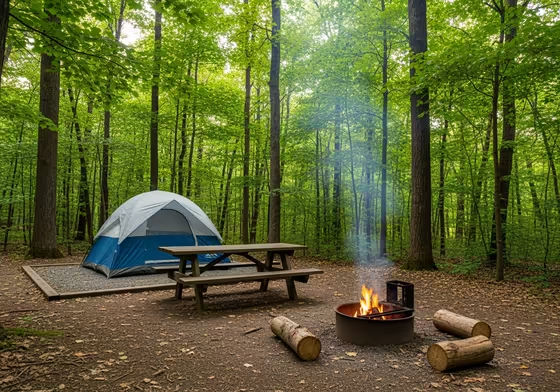
- Amenities: These parks usually have hot showers, flushing toilets, and playgrounds. You can also buy firewood and ice.
- Reservations: You must book your site months in advance for summer or fall weekends. Use the ReserveAmerica system as soon as booking opens.
-
Iconic Parks:
- Watkins Glen State Park: This is the most famous park in the Finger Lakes. It has a beautiful gorge trail with 19 waterfalls. It can be crowded, and some campsites are close together.
- Other Great Parks: Robert H. Treman, Buttermilk Falls, and Taughnock Falls state parks are also nearby. They all have amazing gorges and waterfalls.
Tier 2: Private Campgrounds & RV Parks
These places, like KOA, are great options if you are renting an RV or if state parks are full. They often have full hookups for electricity, water, and sewer. They also have amenities like camp stores.
Tier 3 (For Experts): Finger Lakes National Forest
This is New York's only National Forest and offers a more rugged experience. It's the only place in the area where you can legally camp for free. This is called dispersed camping.
-
The Rules:
This is primitive camping with strict rules. You have to be completely self-sufficient.
- There are no toilets, running water, picnic tables, or fire rings.
- You must camp at least 150 feet away from any trail, road, or water.
- You must follow all Leave No Trace rules, which means packing out everything you bring in.
- Recommendation: First-time campers should not try dispersed camping. It's for experts who have already mastered their gear and know how to be self-sufficient.
Waterfront Camping & Backpacking
- Waterfront Camping: Campsites on the water are very popular. State parks like Sampson and Taughannock Falls offer them. These are the first sites to get booked, so reserve early.
- Backpacking (The Finger Lakes Trail): The Finger Lakes Trail system runs through the region. You can camp along the trail in state forests. There are also simple shelters called lean-tos, which are first-come, first-served and must be shared.
Table 2: Finger Lakes Campsite Options: A First-Timer's Guide
| Camping Type | Typical Amenities | Reservation | Cost | Best For... |
|---|---|---|---|---|
| NY State Park | Hot showers, flush toilets, pool, playground, fire ring, picnic table. | Essential. Book 3-9 months in advance on ReserveAmerica. | $$ (Approx. $20-$35/night) | First-Timers. Learning gear in a safe, controlled environment. |
| Private Campground/RV Park | Full RV hookups (electric, water, sewer), camp store, Wi-Fi. | Recommended. | $$$ (Approx. $50-$90/night) | First-time RV campers or if state parks are full. |
| FLNF Dispersed Camping | None. No toilets, no water, no tables, no fire rings. | None. | Free | Experts Only. Must be 100% self-sufficient and follow Leave No Trace rules. |
What to Pack for Your Trip
Having the right gear makes a big difference. When you are prepared, you feel more confident. Here's a list of what you'll need.
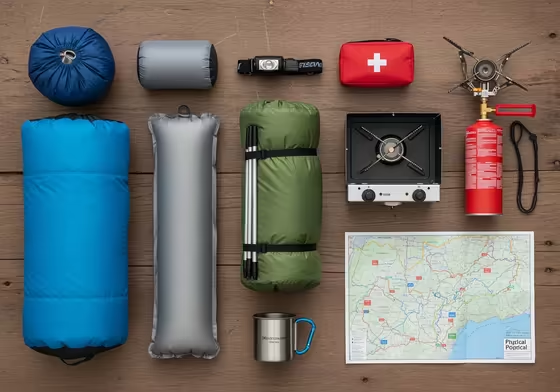
The Ultimate First-Timer's Gear Checklist
-
Shelter & Sleep:
- Tent (3-season)
- Tent Footprint (or Tarp)
- Tent Stakes (and a few extra)
- Mallet or Hammer
- Sleeping Bag (right for the season)
- Sleeping Pad (insulated)
- Pillow
-
Camp Kitchen:
- Camp Stove (2-burner) and Fuel
- Lighter or Waterproof Matches
- Pot and Pan (1 each)
- Plates, Bowls, Mugs (1 set per person)
- Eating Utensils
- Cooking Utensils (spatula, knife, cutting board)
- Cooler and Ice
- Wash Bins (2), Biodegradable Soap, Sponge
- Trash Bags (multiple)
- Can Opener
- Pot Holder
-
Safety & Navigation:
- First-Aid Kit
- Headlamp (1 per person)
- Extra Batteries
- Physical Map and Compass
- Insect Repellent
- Sunscreen and Sunglasses
-
Personal & Comfort:
- Toiletries (toothbrush, toothpaste, etc.)
- Quick-Dry Towel
- Camp Chairs
- Portable Power Bank
Your Tent and Sleeping Gear
Your tent is your home away from home.
- Tent: A "3-season" tent works for spring, summer, and fall.
- Rainfly: This is the waterproof outer layer of your tent. You need to use it to stay dry.
- Tent Footprint: This is a tarp that goes under your tent. It protects the tent floor from rocks. It also stops moisture from the ground from getting inside.
- Stakes & Mallet: It's a good idea to bring a few extra stakes. A mallet helps you secure them in hard ground.
- Pro-Tip: Always set up your new tent at home before your trip. This helps you learn how it works and make sure you have all the parts.
Getting a Good Night's Sleep
A warm night's sleep is key to a great camping trip. It's not just about the sleeping bag. You need a full system to stay warm.
- Sleeping Bag: Make sure your bag is rated for the season. For most trips, a bag rated for 20°F to 30°F is a good choice. Pick a bag rated for temperatures colder than you expect to face.
- Sleeping Pad: This is probably the most important part of your sleep system . It's not just for comfort; it provides insulation from the cold ground. An air mattress won't keep you warm enough on a cold night.
- Pillow: This is easy to forget but makes a huge difference. A camp pillow or one from home will help you sleep much better.
How to Dress for Camping
The secret to staying comfortable outdoors is layering your clothes. This system lets you manage your body temperature.
- Base Layer: This is the layer against your skin. Its job is to pull sweat away from your body to keep you dry. Use materials like wool or polyester.
- Mid-Layer: This is your insulation layer that traps heat. A fleece jacket is a perfect example.
- Outer Layer (Shell): This layer protects you from wind and rain. It should be waterproof.
The "No Cotton" Rule is very important . Cotton absorbs water and loses all its warmth when wet. This can make you dangerously cold.
Dry Sleep Clothes
Always keep a set of dry clothes just for sleeping. This usually includes thermal underwear and warm wool socks. Never wear these clothes outside the tent to keep them clean and dry.
Cooking at Your Campsite
Beginner's Camp Kitchen Checklist
- Two-burner camp stove and fuel
- Lighter and waterproof matches
- One pot and one pan
- Plates, bowls, mugs, and eating utensils
- Cooking utensils (spatula, large spoon)
- Sharp knife and small cutting board
- Cooler with ice
- Two wash bins (one for soapy water, one for rinsing)
- Biodegradable soap and sponge
- Trash bags
- Commonly Forgotten: Can opener, pot holder

Easy Meal Ideas
The key to easy camp cooking is to prepare as much as you can at home. Chop your veggies and pre-cook meats before you leave.
- Breakfast: Pancake mix that only needs water is easy. You can also bring pre-made breakfast burritos or yogurt with granola.
- Lunch: Sandwiches are always a good choice. Wraps with pita bread and hummus are also simple and tasty.
- Dinner: Hot dogs and s'mores are classic camp food. You can also make foil-packet meals with sausage and veggies.
How to Store Your Food
Storing food correctly is not just about convenience. It is a critical safety rule to prevent problems with wildlife.
- The #1 Rule: Never, ever keep food in your tent. This is the main cause of unwanted animal visits.
- What is "Food"? This rule applies to anything with a smell. This includes all food, trash, pet food, and toiletries like toothpaste and soap.
- How to Store: When you are at a campsite with a car, the solution is easy. Store everything in your locked vehicle.
- Coolers: Raccoons are smart and can open normal coolers. If you can't put it in the car, you may need a special bear-resistant cooler.
Important Safety Items
It's smart to have a few key items for safety. Here's a simple list to help you remember what to bring.
- Cutting Tool: A multi-tool or a pocket knife is useful for many small tasks.
- Combustion Device: Bring a reliable way to start a fire. It's a good idea to have three sources: a lighter, waterproof matches, and a fire starter.
- Cover: An emergency blanket is lightweight and good to have in your daypack just in case.
- Container: A metal water bottle is great. In an emergency, you could use it to boil water.
- Cordage: About 50 feet of strong cord has many uses, from a clothesline to a replacement shoelace.
- Compass: Bring a simple compass and a physical map. Your phone battery can die, so this is an important backup for navigation.
- Light: A headlamp is much better than a flashlight. It keeps your hands free for cooking or setting up your tent in the dark.
Other important items include a first-aid kit, sunscreen, and insect repellent.
Commonly Forgotten Items
Here is a quick list of small things that can cause big problems if you forget them.
- Fire: Lighter or waterproof matches.
- Kitchen: Can opener, pot holders, dish soap, and trash bags.
- Shelter: Tent footprint, tent stakes, and a mallet.
- Comfort: Pillow and camp chairs.
- Power: Extra batteries for your headlamp and a portable power bank for your phone.
At the Campsite: Safety and Rules
Dealing with Wildlife
Many new campers worry about wildlife. The best way to handle this fear is to know which animals you might actually see. You might worry about bears, but raccoons are the more common pest.
Are there bears in the Finger Lakes?
- Short Answer: Yes. The Finger Lakes region has a healthy population of black bears.
- The Reality: Black bears are usually shy and try to avoid people. They are looking for an easy meal, not trouble. Your job is to make sure you don't provide one.
- Bear Safety Rules: At a campsite, you must store all scented items in a locked car . This includes all food, trash, coolers, pet food, and toiletries.
- If You See a Bear: Never run. Make yourself look big and get loud by yelling and banging pots. Back away slowly, but do not throw food at it.
The Real Nuisance: Raccoons
You are much more likely to see a raccoon than a bear. These animals are smart and not shy. They can open coolers and will steal any food you leave out.
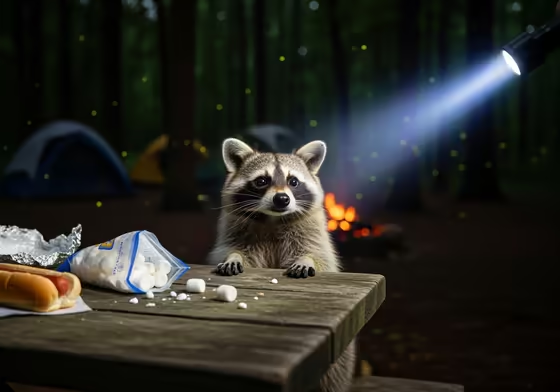
The solution is simple. The same rules for keeping bears away work perfectly for raccoons. Keep all your scented items locked in your car, and you won't have a problem.
Preventing Ticks and Mosquitoes
- Use an insect repellent.
- Wear long sleeves and pants when hiking.
- Check yourself and your pets for ticks every day.
Campfire Safety
The Legal Rule: "Buy It Where You Burn It"
This is a New York State law that every camper must follow.
- The Law: It is illegal to move untreated firewood more than 50 miles. You also cannot bring firewood into New York from another state.
- The Reason: This law helps protect the forests. Bugs that kill trees can hide in firewood. Moving firewood can spread these pests to new areas.
- What to Do: You must buy your firewood at the campground or from a local seller near your campsite.

How to Put Out Your Fire
- Use only the fire rings provided at your campsite.
- Never leave a fire unattended, even for a minute.
- Your fire is not out until it is cold.
- Pour water on all the embers.
- Stir the ashes with a stick to find any hidden embers.
- Pour more water on it.
- The fire is out only when you can hold your hand over the ashes and feel no heat.
Tips for New RV Campers
If you are new to RV camping, think like a pilot. Always do pre-trip checks to avoid common problems. Your RV is a large vehicle that needs careful handling.
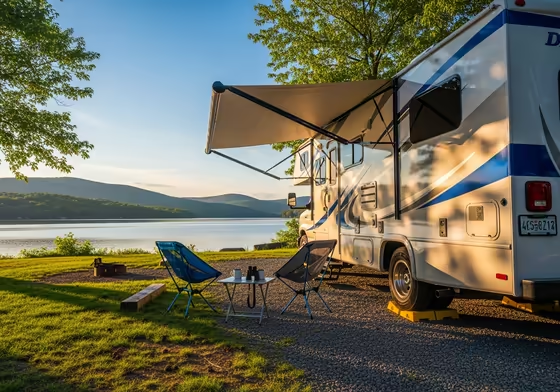
Common Mistakes to Avoid
- 1. Overpacking: RVs have strict weight limits . Overpacking is dangerous and wastes fuel.
- 2. Not Planning the Route: Use an RV-specific GPS to avoid low bridges and steep roads.
- 3. Not Leveling the RV: If your RV isn't level, the frame can be strained. Also, your refrigerator won't work correctly.
- 4. Not Securing Items Inside: Anything loose can fly around and break while you're driving. Check all cabinets and secure loose items before you move.
- 5. Forgetting Checks: Before you leave any spot, do a walk-around. Check tire pressure and make sure all hookups are disconnected.
RV Campground Etiquette
-
Generator Use:
This is a big source of problems in campgrounds.
- The Rules: New York State Campgrounds have strict hours for generators . You can typically only run them for a few hours in the morning and evening.
- Quiet Hours: These are usually from 10 p.m. to 7 a.m. No generators are allowed during this time.
- Medical Needs: If you need power for a medical device like a CPAP machine, book a site with an electric hookup. You cannot rely on a generator running all night.
- Site Boundaries: Respect your neighbor's space. Do not cut through their campsite, and keep noise to a reasonable level.
Frequently Asked Questions
What do I absolutely need as a first-time camper?
If you feel overwhelmed by long packing lists, just focus on the "Big 4." As long as you can stay dry, warm, and fed, your trip will be a success.
- Shelter: A tent that you've already practiced setting up at home.
- Sleep System: A sleeping bag and an insulated sleeping pad. You need both to stay warm.
- Safety: A headlamp with extra batteries and a first-aid kit.
- Food/Water: A simple stove and a cooler to store your food.
Are the Finger Lakes clean and safe for swimming?
Yes, swimming is a big part of the Finger Lakes experience. But you need to be aware of something called Harmful Algal Blooms (HABs).
- The Hazard: All 11 Finger Lakes have had issues with toxic algae. These blooms can be harmful to people and especially to pets.
- What to Look For: The water might look like spilled paint or have a "pea soup" color. You might also see streaks or foam on the surface.
- The #1 Rule: "When in Doubt, Stay Out." Do not swim in or let pets drink any water that looks strange.
Can you really camp for free in the Finger Lakes National Forest?
Yes, this is called "dispersed camping."
-
The Catch:
This is primitive camping and is
not for beginners
.
- There are absolutely no amenities. This means no toilets, no running water, and no fire rings.
- You must camp 150 feet away from any trail, road, or water source.
- You have to be 100% self-sufficient and pack out all of your trash.
- Recommendation: A first-time camper should start in a State Park. You can try free camping after you have more experience.
What is the single most forgotten item by campers?
People forget a lot of things, but these three small items cause the biggest issues.
- A Way to Make Fire: A lighter or waterproof matches. It's smart to pack a few in different places.
- A Kitchen Tool: The can opener. If you are bringing canned food, you will be very unhappy if you forget this.
- Comfort: The pillow. Sleeping on a balled-up jacket is not very comfortable.